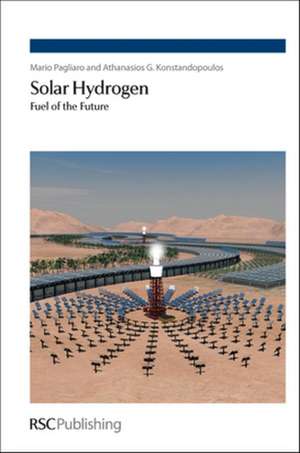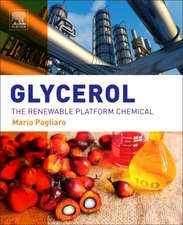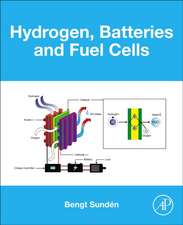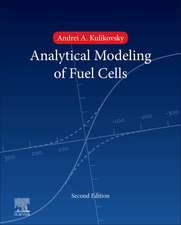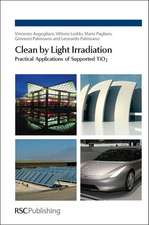Solar Hydrogen: Fuel of the Future
Autor Mario Pagliaro, Athanasios G. Konstandopoulosen Limba Engleză Hardback – 31 mai 2012
Renewable hydrogen produced using solar energy to split water is the energy fuel of the future. Accelerated innovation in both major domains of solar energy (photovoltaics and concentrated solar power) has resulted in the rapid fall of the solar electricity price, opening the route to a number of practical applications using solar H2. New thermochemical water splitting using concentrated solar power (CSP) as well as CSP coupled to electrolysis has the potential to convert and store solar energy into clean hydrogen using a tiny fraction of the world's desert area to meet our present and future global energy needs. Photovoltaics, in turn, has the versatility required for supporting the creation of a distributed energy generation infrastructure in developing countries especially now that the price of PV solar electricity has fallen to unprecedented low levels. In all these cases, solar H2 will be used to store energy and release it on demand either for fuel cells (to power homes and boats) or internal combustion engines and turbines (for powering cars, trucks and in thermoelectric power units). This book on solar hydrogen is unique in its field and is a timely treatment of a hot topic in industry, academic, political and environmental circles. With reference to many examples as well as to new technologies, this accessible book provides insight into a crucial technology for our common future and numerous colour pictures contribute to the book's readability. Written by experts in the field who are engaged at the forefront of research, the book supplies readers with last minute insight from the frontiers of research. The book will be of interest to Politicians, solar PV companies, hydrogen and sustainability researchers, environmentalists, managers in the automotive and nautical industries, undergraduate and graduate students in physics, chemistry, energy and materials science.
Preț: 640.83 lei
Preț vechi: 720.03 lei
-11% Nou
Puncte Express: 961
Preț estimativ în valută:
122.64€ • 127.56$ • 101.24£
122.64€ • 127.56$ • 101.24£
Carte disponibilă
Livrare economică 25 martie-08 aprilie
Preluare comenzi: 021 569.72.76
Specificații
ISBN-13: 9781849731959
ISBN-10: 1849731950
Pagini: 184
Dimensiuni: 162 x 236 x 17 mm
Greutate: 0.29 kg
Editura: Royal Society Of Chemistry
ISBN-10: 1849731950
Pagini: 184
Dimensiuni: 162 x 236 x 17 mm
Greutate: 0.29 kg
Editura: Royal Society Of Chemistry
Cuprins
The Energy Problem; Hydrogen and Solar Hydrogen Basic; Water Electrolysis with Solar Electricity; Thermochemical Water Splitting; Helionomics: Solar Hydrogen Economy
Notă biografică
Mario Pagliaro, a scholar at Italy's Research Council based in Palermo, is the founder and director of Sicily's Photovoltaics Research Pole. His research interests are in materials chemistry, solar energy, science methodology and management. Mario is the author of a large body of research papers and scientific books. His joint achievements include the commercialization of several new chemical technologies. Athanasios G Konstandopoulos, founder and Director of APT Lab at CPERI/CERTH and a member of the faculty of Aristotle University of Thessaloniki, Greece, is the coordinator of the European "Hydrosol" projects. He is an expert in aerosol/nanoparticle technologies and multifunctional structured reactors with applications in combustion engine emission control, solar hydrogen/fuels production and biotechnology. He is the recipient of many awards, including the 2006 Descartes Prize of the European Commission.
Textul de pe ultima copertă
Renewable hydrogen produced using solar energy to split water is an energy fuel of the future. Accelerated innovation in both major domains of solar energy (photovoltaics and concentrated solar power) has resulted in the rapid fall of the solar electricity price, opening the route to a number of practical applications using solar H2. New thermochemical water splitting using concentrated solar power (CSP) coupled to nanocatalysis has the potential to convert and store solar energy into clean hydrogen using a tiny fraction of the world's surface area to meet our present and future global energy needs. Photovoltaics, in turn, has the versatility required for supporting the creation of a distributed energy generation infrastructure especially now that the price of PV solar electricity has fallen to unprecedented low levels. In all these cases, solar H2 will be used to store energy and release it on demand either for fuel cells (to power homes and boats) or internal combustion engines and turbines (for powering cars, trucks and in thermoelectric power units). This book on solar hydrogen is unique in its field and is a timely treatment of a hot topic in industrial, academic, political and environmental circles. With reference to many examples as well as to new technologies, this accessible book provides insight into a crucial technology for our common future and numerous colour pictures contribute to the book's readability. Written by experts in the field who are engaged at the forefront of research, the book supplies readers with last-minute insight from the frontiers of research. The book will be of interest to politicians, solar hydrogen and PV companies, hydrogen and sustainability researchers, environmentalists, managers in the automotive and nautical industries, undergraduate and graduate students in physics, chemistry, energy and materials science.
Descriere
With reference to many examples as well as to new technologies, written by experts in the field, this accessible book provides insight into a crucial technology and numerous color pictures contribute to the book's readability.
